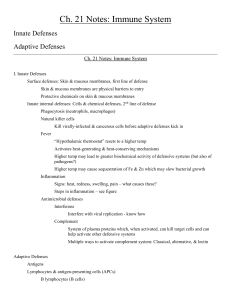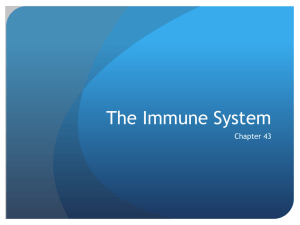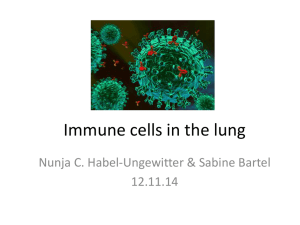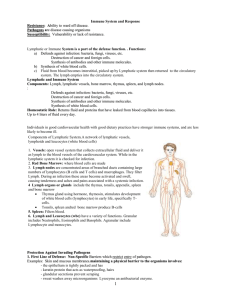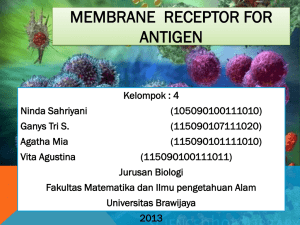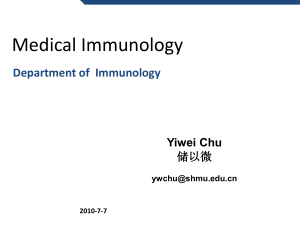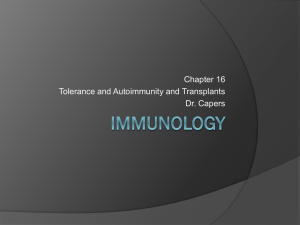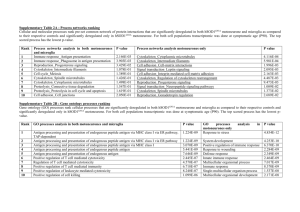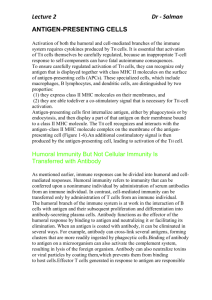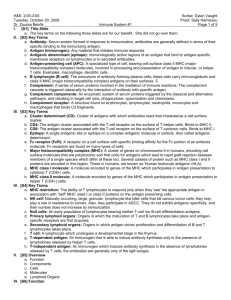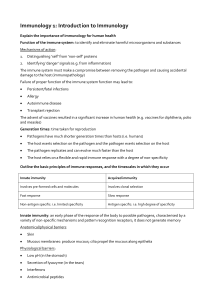BaumanEd_Ch16_ACTQ
advertisement
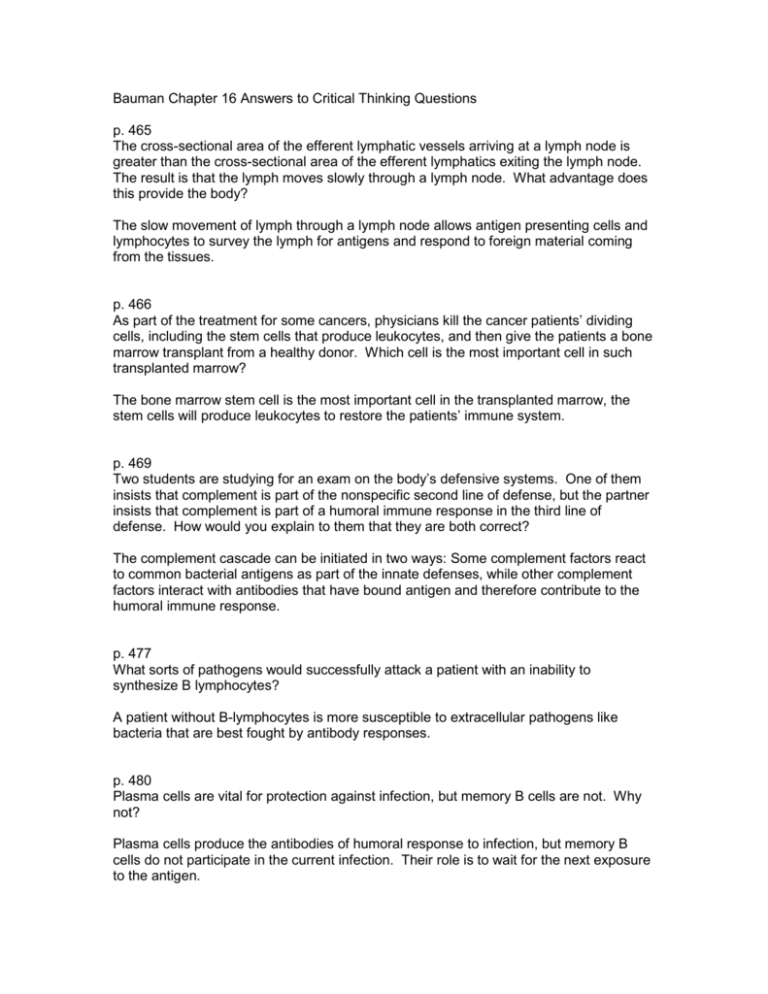
Bauman Chapter 16 Answers to Critical Thinking Questions p. 465 The cross-sectional area of the efferent lymphatic vessels arriving at a lymph node is greater than the cross-sectional area of the efferent lymphatics exiting the lymph node. The result is that the lymph moves slowly through a lymph node. What advantage does this provide the body? The slow movement of lymph through a lymph node allows antigen presenting cells and lymphocytes to survey the lymph for antigens and respond to foreign material coming from the tissues. p. 466 As part of the treatment for some cancers, physicians kill the cancer patients’ dividing cells, including the stem cells that produce leukocytes, and then give the patients a bone marrow transplant from a healthy donor. Which cell is the most important cell in such transplanted marrow? The bone marrow stem cell is the most important cell in the transplanted marrow, the stem cells will produce leukocytes to restore the patients’ immune system. p. 469 Two students are studying for an exam on the body’s defensive systems. One of them insists that complement is part of the nonspecific second line of defense, but the partner insists that complement is part of a humoral immune response in the third line of defense. How would you explain to them that they are both correct? The complement cascade can be initiated in two ways: Some complement factors react to common bacterial antigens as part of the innate defenses, while other complement factors interact with antibodies that have bound antigen and therefore contribute to the humoral immune response. p. 477 What sorts of pathogens would successfully attack a patient with an inability to synthesize B lymphocytes? A patient without B-lymphocytes is more susceptible to extracellular pathogens like bacteria that are best fought by antibody responses. p. 480 Plasma cells are vital for protection against infection, but memory B cells are not. Why not? Plasma cells produce the antibodies of humoral response to infection, but memory B cells do not participate in the current infection. Their role is to wait for the next exposure to the antigen. p. 481 Why did scientists give the name “perforin” to this molecule secreted by TC cells? Perforin molecules assemble to form a structure that “perforates” the cell membrane. p. 482 What sorts of pathogens could successfully attack a patient with an inability to produce T lymphocytes? A patient who lacks T lymphocytes is susceptible to all sorts of infections without the T helper cells to coordinate both humoral and cellular immune responses. p. 486 1. Why is it advantageous that the lymphatic system lacks a pump? A pump in the lymphatic system would interfere with functions that help fight microbial invasion. Slow movement of lymph through the lymph nodes increases the opportunity for antigen presenting cells and lymphocytes to screen the lymph for foreign material and respond to it. Edema of the tissues creates a pressure barrier that can slow the spread of microbes in the tissues, a pump would reduce the pressure and allow microbes to spread easier. 2. Contrast nonspecific defenses with specific immunity. Nonspecific defenses respond to invading microbes on the basis of structures common to classes of microbe (e.g. Gram-negative LPS, non-self fragments on the surface of infected cells). The nonspecific defenses respond quickly to the presence of microbes that have these common features, but will not respond to organisms that do not have them. The nonspecific defenses do not improve with repeated exposure. Specific immunity detects and responds to active infection with components that target distinct, often unique, structures of the invading antigen, and develops the response appropriate to the invader (e.g. humoral for bacteria, cellular for viruses). The response to the initial invasion is slow while the cells arm themselves, but the response to subsequent exposures is faster, and with each exposure the specific immune response to that microbe improves, becoming more vigorous and more fine-tuned. 3. What is the benefit to the body of requiring the immune system to process antigen? Microorganisms are structurally complex, and while they may have many antigenic determinants the immune system can potentially respond to, the antigenic determinants may not be accessible. Antigen processing breaks up complex microbial structures into their component pieces, increasing the number of antigenic determinants available for potential response from the T and B cells. This in turn increases the number of lymphocytes that can be activated against the invader. 4. Scientists can develop genetically deficient strains of mice. Describe the immunological impairments that would result in mice deficient in each of the following: class I MHC, class II MHC, TCR, BCR, IL-2 receptor, or IFN- γ. Class I MHC, which are produced by nearly all cell types in the body, function in antigen presentation of the antigenic determinants from intracellular parasites; without them, the mice are highly susceptible to infection by viruses and other intracellular pathogens. Class II MHC are produced by antigen presenting cells for use in presenting antigen to T helper cells, which require antigen presentation to become activated; a lack of MHC II results in the inability to fully develop an immune response. The T cell receptor, TCR, is the molecule by which the T cell detects presented antigen; without TCR, T cells will not become activated and the immune response will not develop. The B cell receptor (BCR) is the B cell’s antigen recognition molecule; without the ability to bind antigen, B cells are not activated and a humoral response cannot develop. IL-2 stimulates activated lymphocytes to proliferate; without a receptor for IL-2 activated lymphocytes do not undergo cell division to produce the clonal population needed to effectively fight infections. Interferon-γ (INF- γ) is required for activation cytotoxic T cells, and a lack of cytotoxic T cells reduces the ability to fight infection by intracellular parasites and to fight cancer. 5. Human immunodeficiency virus (HIV) preferentially destroys CD4 cells. Specifically, what effect does this have on humoral and cell-mediated immunity? The CD4 cells that HIV preferentially infects are the T helper cells and macrophages. The T helper cells coordinate the acquired immune response, their destruction results in the body no longer being capable of producing humoral or cell-mediated immune responses. 6. What would happen to a person who failed to make MHC molecules? An acquired immune response will not develop in the absence of MHC molecules, which are required for antigen presentation to activate B and T lymphocytes. 7. Why does the body make five difference classes of immunoglobulins? The various antibody classes have somewhat different roles in immunity. Immunoglobulin M (IgM) serves as the antigen receptor for B cells, and as an early product of the immune response that is highly efficient. IgG, the “serum” antibody is secreted into the bodily fluids, is abundant in the blood and is small enough to enter the fluids of the tissues to react to antigens in the extracellular fluids. IgA is found in bodily secretions, including mucous, tears, and milk, where the antibodies can react with antigens in body cavities (nasal cavity, digestive tract, etc.) and protect the newborn. IgE that has bound antigen interacts with granulocytes to trigger the release of inflammatory signals and participate in the attack by eosinophils on parasitic worms. 8. Some materials such as metal bone pins and plastic heart valves can be implanted into the body without fear of rejection by the patient’s immune system. Why is this? What are the ideal properties of any material that is to be implanted? The body’s defenses respond primarily to biomolecules, particularly proteins but also lipids and carbohydrates, that can be bound in the groove of MHC molecules. Metals and most plastics do not have the type of molecular structure the MHC is capable of binding for antigen presentation. Implanted materials should ideally be inert and not immunogenic.



